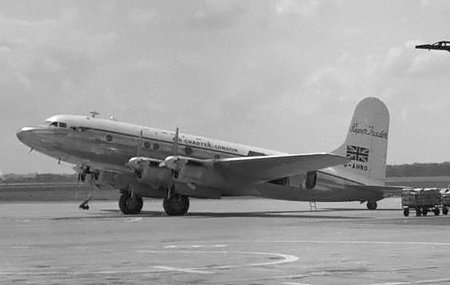Tudor Star Tiger
Disappearance in Bermuda Triangle
On January 30, 1948, the Star Tiger, a Tudor aircraft was on its way to Bermuda. The long 12 hours journey from Santa Maria in Azores was almost coming to an end. At 3:15 a.m., the radio operator of the aircraft received the radio position of the plane. It was all set to land at 5am and in only one and half hours time, the 25 passengers on board would see the marine lights of Bermuda. But it was well past 5am, and the Star Tiger did not make a landing. The plane was never seen or heard of again.
Avro Tudor Mark IVB (similar to Star Tiger)
Source: Wikimedia Commons
Here is the full story of Tudor Star Tiger's mysterious disappearance in Bermuda Triangle.
The Background
Star Tiger was the third Tudor Mark IV aircraft that was ordered by the British South American Airways (BSAA). It was an extended and improved Tudor aircraft manufactured by the Avro Corporation. Avro also manufactured two other types: Yorks and Lancastrians. In 1948, the Tudor was a relatively new aircraft and had history of 575 hours of flying experience from the time it was first launched. However, there was no prior incidence of accidents or malfunction.
The Dreaded Flight of Tudor Star Tiger
On January 28, 1948, Star Tiger started from Lisbon for its first leg of journey to Santa Maria in the Azores. It was supposed to be a short halt for refueling. But due to bad weather conditions and strong winds, the Captain Brian W McMillan decided that they would fly to Bermuda the next day.
So on 29th January, the flight took off from Santa Maria despite strong winds. There were 25 passengers on board, and one of them a very distinguished person - Air Marshal Sir Arthur Coningham, a hero of World War II.
The captain decided to fly at an exceptionally low altitude of 2000 feet in order to avoid the strong headwind that originates particularly due to the Gulf stream at the Atlantic and more so in the winter. At 3:15 a.m., when most passengers were sleeping or dozing, the radio operator of the flight pressed a button to get position of the plane from Bermuda's radio operator.
The Bermuda operator responded giving the position of the plane at 72 degrees. On receiving the message, the Captain McMillan and the flight radio operator agreed that the Estimated Time of Arrival at Bermuda would be 5a.m.
The Bermuda operator tried to contact the Star Tiger later at 3:50am but got no response. He tried again at 4:40am when it was almost time for the fight to start its descend for landing. He did not get any response again and immediately declared a state of emergency.
The plane's landing time of 5am had long passed. There was no trace of the flight, nor there was any distress call raised by the captain of the flight.
There was a massive rescue operation launched by the USAAF (US Army Air Force based at Kindley Field, Bermuda) with 26 aircraft flying for 882 hours to search for the Star Tiger. The operation lasted for 5 days and was eventually abandoned due to bad weather.
But they found no trace of it or its passengers and the crew. On January 31, 1948, the news of the passenger Sir Arthur Coningham's death shared the front page of The New York Times along with other terrible news of Mahatma Gandhi's assassination and the death of Orville Wright.
Investigation on the disappearance of Star Tiger
The British Aviation Ministry immediately grounded the other two Tudor aircraft owned by the BSAA airlines although they were later released only for cargo operation. The ministry also initiated a thorough investigation headed by Lord MacMillan. The investigation lasted for 11 days.
The team came back with a lot of observations on what could NOT have happened rather than what might have happened to the Star Tiger flight. Very rare to be seen in the history of such investigations, the team admitted its inability to get to the real cause. This is what the final report said:
"In closing this report it may truly be said that no more baffling problem has ever been presented for investigation. In the complete absence of any reliable evidence as to either the nature or the cause of the accident of Star Tiger the Court has not been able to do more than suggest possibilities, none of which reaches the level even of probability. Into all activities which involve the co-operation of man and machine two elements enter of a very diverse character.
There is an incalculable element of the human equation dependent upon imperfectly known factors; and there is the mechanical element subject to quite different laws. A breakdown may occur in either separately or in both in conjunction. Or some external cause may overwhelm both the men and the machine. What happened in this case will never be known and the fate of Star Tiger must remain an unsolved mystery."
So what was the cause of Star Tiger disappearance?
Did the Star Tiger run out of fuel? Improbable. It was confirmed by the investigators that with its fuel tank capacity, it should have had fuel for at least one more hour of flying even after reaching Bermuda.
Was it an engine failure? The Tudor Mark IV aircraft had four engines. It is known that with the reduced load of the fuel, the aircraft could easily fly with 3 or even 2 engines. Three engines failing all at the same time would be quite unbelievable.
Was it a structural failure or collapse? Even if it was a structural failure due to strong wind, the Star Tiger was flying at such a low height of 2000 feet that there should not have been any problems with the cabin pressure. So the passengers should have been all safe.
There was no distress call made by the crew either. Many receiving stations were listening on Star Tiger's frequency, and none heard anything.
Well, that leads to only one other possibility. In several communication with the Bermuda radio operators, the crew wrongly transmitted the altitude of the flight as 20,000 feet instead of 2,000 feet. A Tudor aircraft typically flies at 20,000 feet. Remember, it was a long tiring flight and in such wee hours all must had been really fatigued.
So, when the flight started its descend, it is possible the crew forgot they were flying at only 2,000 feet. By the time anyone realized, the crew simply flew the aircraft into the sea. It is quite likely that the an altimeter (measuring altitude) won't function normally at such low altitudes and therefore may not have given any warnings either.
Well, this is only a possibility and the real truth is still unknown.
Larry Kusche (the American research librarian, author and a pilot) in his famous book 'The Bermuda Triangle Mystery - Solved' published in 1975, mentioned that although the loss of the plane Star Tiger remains a mystery, failure to find any trace of its wreckage can not be attributed to a mystery.
The sea was becoming rough towards the latter stage of the flight, the plane was operating in low fuel and the weather too was deteriorating. The plane, if it had to, was left with hardly any chance to ditch into the sea successfully in the dark. And by the time the search craft arrived (which might have been up to 5 - 8 hours from the time of crash), the wreckage could have been easily swept away from the crash site.
|
 By Raj Bhattacharya By Raj Bhattacharya
Raj, a seasoned travel writer and Bermuda destination expert, has extensive global travel experience. This website reflects his profound insights, garnered over nearly two decades of dedicated findings and research on the island. Raj has assisted countless Bermuda-bound visitors by providing direct, personalized responses to their queries and imparting his wealth of knowledge through this platform. This site serves as an indispensable guide for those seeking informed and reliable insights into Bermuda's treasures.
|
Related Articles

 By Raj Bhattacharya
By Raj Bhattacharya